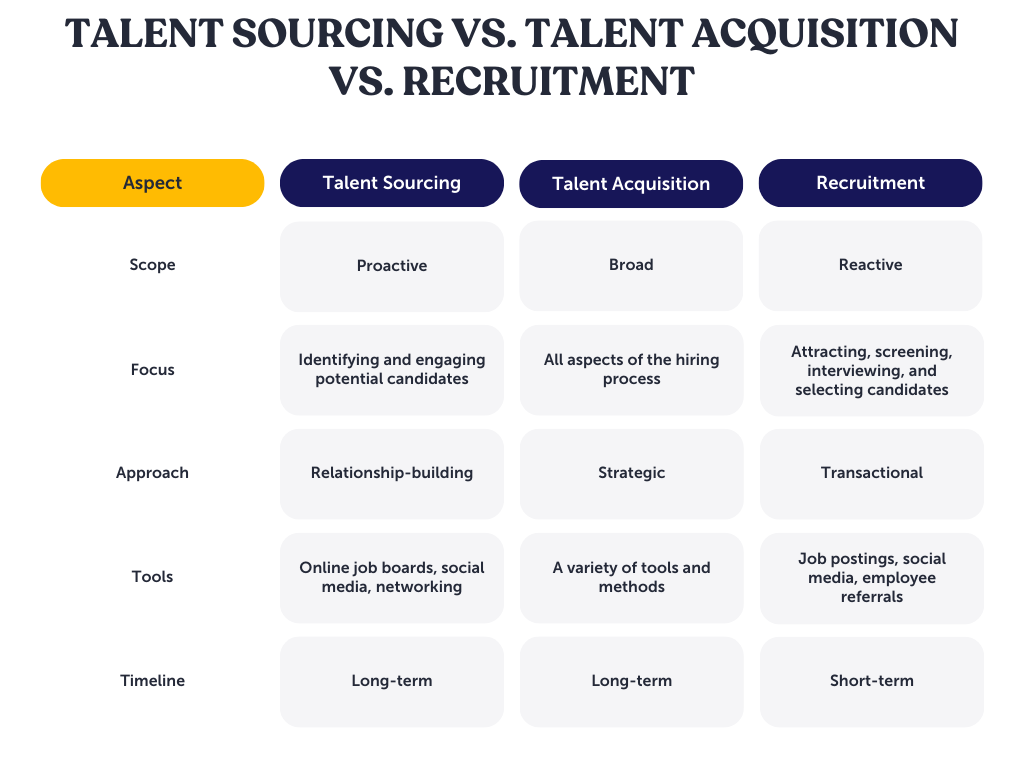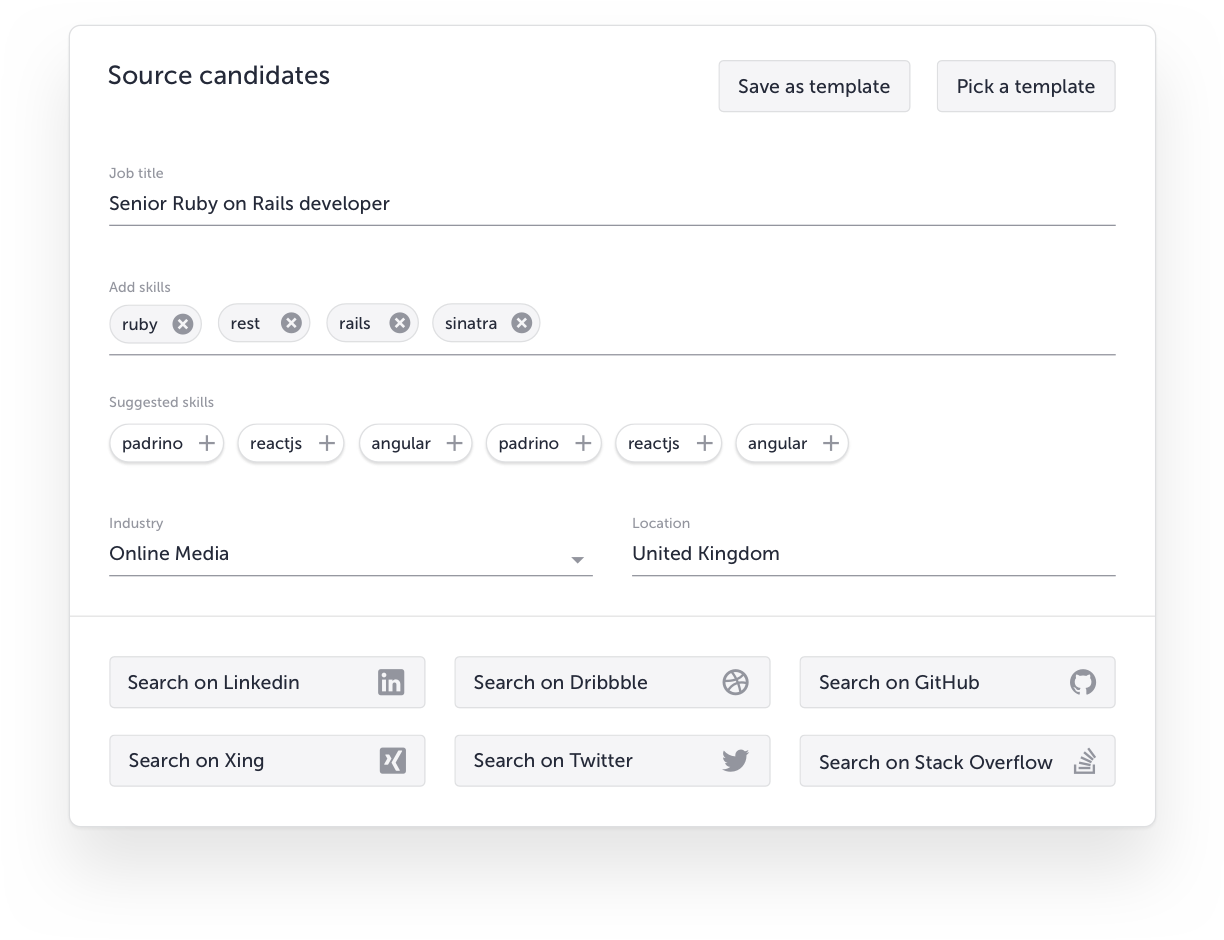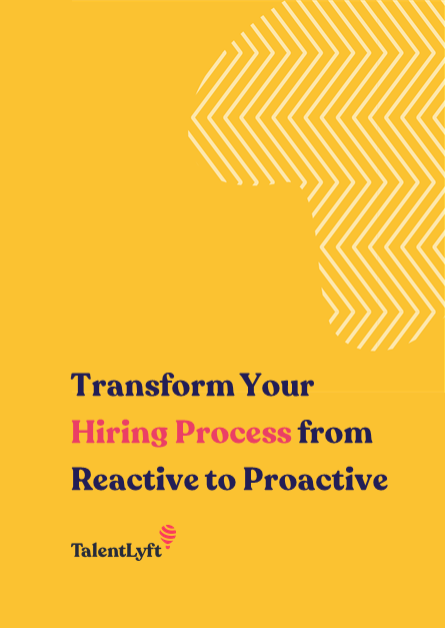![https://adoptoprod.blob.core.windows.net/article/Dm4qeBYsIUavaJfr3sa1Qw.png]()
What is talent sourcing?
Talent sourcing is the strategic process of identifying, attracting, and engaging potential candidates with the skills and qualifications required for specific job roles within an organization. It involves proactive efforts to locate and connect with individuals who may not be actively seeking employment but possess the talents that align with an organization's needs.
Talent sourcing goes beyond traditional job postings and reactive recruitment methods, encompassing techniques such as leveraging social media, online platforms, networking events, and data analysis to build a pool of qualified candidates for current and future positions.
A LinkedIn study showed that 62% of talent teams find more high-quality candidates through sourcing than inbound applications.The goal of talent sourcing is to establish a pipeline of potential hires, streamlining the recruitment process and ensuring a continuous supply of suitable candidates as organizational needs evolve.
The difference between talent sourcing, talent acquisition, and recruitment
Talent sourcing, talent acquisition, and recruitment are interrelated terms that describe different stages and approaches within the process of attracting and hiring new employees. While they are sometimes used interchangeably, they have distinct meanings.
Talent Sourcing
Talent sourcing is the initial step in the hiring process. It involves actively seeking out and identifying future candidates with the desired skills and qualifications for specific job roles to create a talent pool, even if they are not actively looking for a job. Candidate sourcing aims to build a pipeline of potential candidates for future recruitment needs.
Talent Acquisition
Talent acquisition is a broader approach to acquiring talent for an organization. It involves the whole process of identifying, attracting, assessing, and hiring candidates to fulfill current and future roles. Talent acquisition goes beyond the transactional aspects of recruitment and incorporates elements of employer branding, candidate experience, and long-term workforce planning. It focuses on aligning talent with the organization's overall business goals and culture.
Recruitment
Recruitment is the specific process of attracting, screening, interviewing, and selecting candidates for open positions. It involves activities such as posting job openings, reviewing applications, conducting interviews, performing assessments, and making the final hiring decision. It is a reactive process that begins when a hiring manager identifies a need for a new employee.

The process of sourcing candidates
The process of talent sourcing involves several systematic steps aimed at identifying and engaging potential candidates with the right qualifications and skills for specific job roles. Here's a breakdown of the process:
1. Identify Talent needs
The first step in the talent sourcing process is to define the talent need. This includes understanding the role that needs to be filled, the skills and experience that are required, and the desired cultural fit. Create candidate personas - detailed candidate profiles outlining the essential qualifications, skills, experience, and attributes required for each role. This way you’ll know exactly who to look for.
2. Identify the prospects
Once you define your needs, the process of candidate identification begins. Determine the most effective sourcing channels to find the right candidates. These can include online job boards, professional networking platforms (LinkedIn), industry-specific forums, career fairs, and employee referrals. Industry conferences and events are also excellent opportunities to identify individuals who are passionate about their field and are likely to be valuable assets to your organization.
3. Source and engage with active and passive candidates
Initiate conversations with potential candidates that go beyond the typical job inquiry. It's about creating a genuine connection and conveying your company's values, mission, and culture. Personalized messages that highlight how their skills and aspirations align with your organization's goals can capture their interest.
This stage is an opportunity to showcase your company's uniqueness and make candidates feel valued even before formal hiring discussions. Source both active and passive candidates who are not actively looking for a new job but might want to hear what you have to say.
4. Nurture candidates
Talent sourcing is a long-term game, and nurturing relationships with potential candidates is key. Regular communication that offers value to the candidates, such as industry insights, career development tips, and updates about your company's achievements, keeps them engaged and interested. This consistent interaction demonstrates your commitment to their professional growth, solidifying their positive perception of your organization.
5. Convert
The culmination of the talent sourcing process is the conversion phase. When a suitable position opens up within your organization, the candidates you've nurtured become prime candidates for consideration.
At this point, you're not starting from scratch; you're approaching individuals who are already familiar with your company and have expressed genuine interest in being a part of it. This drastically shortens the recruiting process and ensures that you're selecting from a pool of individuals who align with your organization's values.
Transform your Hiring Process from Reactive to Proactive
Sourcing talent represents a proactive approach to hiring. Download our FREE E-Book to learn how to shift your hiring to a more proactive process for more effective and faster recruitment!
Download E-Book Best methods to source talent
In a landscape where competition for skilled professionals is fierce, having a sourcing strategy that involves using various channels is essential to secure the top talent you’re looking for. Here are some of the most effective strategies:
Social media and professional networks
Social media platforms provide more than just a space to post job openings. Actively engaging with potential candidates on platforms like LinkedIn, Twitter, Instagram, and even Facebook can help you form meaningful connections. Sharing valuable content related to your industry, company culture, and career development showcases your organization's expertise and attracts individuals who resonate with your values.
Professional networks like LinkedIn are goldmines for discovering candidates actively seeking new opportunities, as well as those who are content but open to hearing about exciting prospects. LinkedIn's advanced search filters allow you to pinpoint candidates based on specific criteria such as skills, experience, location, and industry.
Online Job Boards
Online job boards such as LinkedIn, Indeed, and Glassdoor provide a broad reach to actively searching candidates. Craft a compelling job description that highlights the role's responsibilities, benefits, and company values to attract potential candidates. Use relevant keywords to ensure your listings appear in search results. Regularly update and refresh your postings to maintain visibility.
Employee Referrals
Current employees can be invaluable assets in the process of candidate sourcing. They not only understand the company culture but also have an interest in bringing in candidates who align with that culture.
Implement an employee referral program to encourage employees to refer candidates from their professional or personal networks and reward the best referrals. This method increases your chances of finding the best candidates drastically as your employees already know exactly what you’re looking for and they get the chance to be rewarded. in fact, 48% of businesses claim that their best hires come from employee referrals. A perfect win-win!
Industry-Specific Platforms
Industry-specific platforms like GitHub and Stack Overflow offer a wealth of resources, discussions, job postings, and networking opportunities that cater directly to the interests and needs of those working in that industry. Utilize these platforms to target candidates with specific skill sets and experiences relevant to your company's needs. This approach can yield candidates that are a perfect fit.
Networking
Networking remains a cornerstone of talent sourcing. Attending industry conferences, seminars, workshops, and networking events provides an opportunity to connect with potential candidates in a more personal and direct manner. Building relationships in person creates a deeper understanding of candidates' skills, aspirations, and values, laying a strong foundation for future collaboration.
Benefits of talent sourcing
Reduced Time to Hire
One of the greatest benefits of talent sourcing is the significant reduction in time-to-hire. By maintaining a pipeline of pre-qualified candidates, organizations can swiftly respond to job openings.
Traditional recruitment processes often involve posting job listings, waiting for applications, and then shortlisting candidates. With talent sourcing, a talent pool of quality candidates is already at your fingertips, enabling you to speed up the selection of candidates and fill the roles quickly.
Higher Quality Candidates
Talent sourcing flips the script on traditional hiring by focusing on proactively identifying and nurturing candidates even before a need arises. This approach attracts candidates who are genuinely interested in your organization, its culture, and its values. As a result, the candidates you engage with are more likely to be aligned with your company's vision, possess the required skills, and match your team’s dynamics.
Cost Savings
Unlike traditional recruitment methods often involve expenses such as job advertisements, agency fees, and the time invested by HR teams, talent sourcing offers a cost-effective alternative. By directly engaging with candidates organizations can significantly cut down on recruitment costs. Moreover, the reduction in time-to-hire means less productivity loss due to unfilled positions, leading to financial savings in the long run.
Reduced Turnover
Talent sourcing goes beyond short-term hiring; it's about building relationships. Engaging with candidates early on allows organizations to assess their long-term compatibility and commitment.
As a result, the candidates sourced through this method are more likely to have a stronger alignment with your organization's values, leading to reduced turnover rates. These employees are more likely to stay onboard and contribute to your company's success over the long haul.
Leveraging software to source candidates
Even though it offers a great ROI, talent sourcing still takes significant time and effort.
After all, you’ve probably experienced the struggle of manually sourcing candidates. You could spend hours searching through online job boards, social media, and networking platforms to find qualified candidates. Not to mention the cost of your time to do it or the even bigger cost of hiring an agency to do it.
Luckily, in today’s tech-driven world, there’s software for everything. And sourcing candidates is no exception.
Leveraging efficient recruitment software helps you speed speeds up the process drastically and enable you to source talent at scale.
That’s why having an excellent all-around software solution is vital to not only attracting candidates with job postings and career sites but actively sourcing and engaging with talent as well.
For example, TalentLyft’s sourcing solution lets you easily search for and engage with prospects that match your hiring needs on the most popular networks like LinkedIn, Xing, Twitter, Github, and StackOverflow.

Besides the powerful sourcing tool, TalentLYft offers an all-round solution that enables you to do it all within a single platform:
You need a tool that not only serves as an ATS but a platform that lets you handle the entire recruitment process from one place. That is the true meaning of streamlining and automation.
Ready to source the best talent out there?
Leverage a powerful sourcing tool to find your ideal candidates from online platforms, referrals, and various other channels, add them to your talent pools, and engage with them.
Try TalentLyft for free! 

















